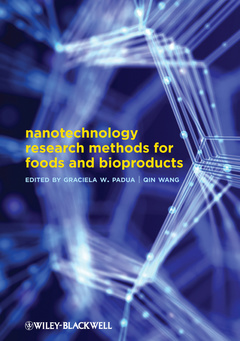Nanotechnology Research Methods for Food and Bioproducts
Auteurs : Padua Graciela Wild, Wang Qin

Contributors xiii
1 Introduction 1
Graciela W. Padua
References 3
2 Material components for nanostructures 5
Graciela W. Padua and Panadda Nonthanum
2.1 Introduction 5
2.2 Self-assembly 6
2.3 Proteins and peptides 8
2.3.1 Amyloidogenic proteins 8
2.3.2 Collagen 9
2.3.3 Gelatin 9
2.3.4 Caseins 10
2.3.5 Wheat gluten 10
2.3.6 Zein 10
2.3.7 Eggshell membranes 10
2.3.8 Bovine serum albumin 11
2.3.9 Enzymes 11
2.4 Carbohydrates 11
2.4.1 Cyclodextrins 11
2.4.2 Cellulose whiskers 12
2.5 Protein–polysaccharides 13
2.6 Liquid crystals 14
2.7 Inorganic materials 14
References 15
3 Self-assembled nanostructures 19
Qin Wang and Boce Zhang
3.1 Introduction 19
3.2 Self-assembly 20
3.2.1 Introduction 20
3.2.2 Micelles 20
3.2.3 Fibers 21
3.2.4 Tubes 23
3.3 Layer-by-layer assembly 24
3.3.1 Introduction 24
3.3.2 Nanofilms on planar surfaces from LbL 25
3.3.3 Nanocoatings from LbL 27
3.3.4 Hollow nanocapsules from LbL 28
3.4 Nanoemulsions 29
3.4.1 Introduction 29
3.4.2 High-energy nanoemulsification methods 30
3.4.3 Low-energy nanoemulsification methods 31
3.4.4 Nanoparticles generated from different nanoemulsions and their applications 33
References 34
4 Nanocomposites 41
Graciela W. Padua, Panadda Nonthanum and Amit Arora
4.1 Introduction 41
4.2 Polymer nanocomposites 42
4.3 Nanocomposite formation 43
4.4 Structure characterization 44
4.5 Biobased nanocomposites 45
4.5.1 Starch nanocomposites 46
4.5.2 Pectin nanocomposites 46
4.5.3 Cellulose nanocomposites 47
4.5.4 Polylactic acid nanocomposites 47
4.5.5 Protein nanocomposites 48
4.6 Conclusion 50
References 50
5 Nanotechnology-enabled delivery systems for food functionalization and fortification 55
Rashmi Tiwari and Paul Takhistov
5.1 Introduction: functional foods 55
5.2 Food matrix and food micro-structure 56
5.3 Target compounds: nutraceuticals 58
5.3.1 Solubility and bioavailability of nutraceuticals 60
5.3.2 Interaction of nutraceuticals with food matrix 61
5.4 Delivery systems 64
5.4.1 Overcoming biological barriers 64
5.4.2 Nano-scale delivery systems 65
5.4.3 Types/design principles 67
5.4.4 Modes of action 69
5.5 Examples of nanoscale delivery systems for food functionalization 72
5.5.1 Liposomes 72
5.5.2 Nano-cochleates 74
5.5.3 Hydrogels-based nanoparticles 75
5.5.4 Micellar systems 75
5.5.5 Dendrimers 77
5.5.6 Polymeric nanoparticles 78
5.5.7 Nanoemulsions 80
5.5.8 Lipid nanoparticles 81
5.5.9 Nanocrystalline particles 83
5.6 Conclusions 85
References 85
6 Scanning electron microscopy 103
Yi Wang and Vania Petrova
6.1 Background 103
6.1.1 Introduction to the scanning electron microscope 103
6.1.2 Why electrons? 104
6.1.3 Electron–target interaction 104
6.1.4 Secondary electrons (SEs) 105
6.1.5 Backscattered electrons (BSEs) 106
6.1.6 Characteristic X-rays 107
6.1.7 Overview of the SEM 107
6.1.8 Electron sources 108
6.1.9 Lenses and apertures 109
6.1.10 Electron beam scanning 109
6.1.11 Lens aberrations 110
6.1.12 Vacuum 111
6.1.13 Conductive coatings 111
6.1.14 Environmental SEMs (ESEMs) 111
6.2 Applications 111
6.2.1 Zein microstructures 112
6.2.2 Controlled magnifications 115
6.2.3 Nanoparticles 117
6.3 Limitations 119
6.3.1 Radiation damage 120
6.3.2 Contamination 122
6.3.3 Charging 124
References 126
7 Transmission electron microscopy 127
Changhui Lei
7.1 Background 127
7.2 Instrumentations and applications 128
7.2.1 Interactions between incident beam and specimen 129
7.2.2 Conventional TEM 130
7.2.3 Scanning TEM 136
7.2.4 Analytical electron microscopy 139
7.3 Sample preparations 142
7.4 Limitations 143
References 143
8 Dynamic light scattering 145
Leilei Yin
8.1 The principle of dynamic light scattering 145
8.2 Photon correlation spectroscopy 151
8.3 DLS apparatus 152
8.4 DLS data analysis 156
8.4.1 Multiple-decay methods 158
8.4.2 Regularization methods 158
8.4.3 Maximum-entropy method 159
8.4.4 Cumulant method 159
References 160
9 X-ray diffraction 163
Yi Wang and Phillip H. Geil
9.1 Background 163
9.1.1 Introduction 163
9.1.2 Classical X-ray setup 165
9.1.3 X-ray sources 165
9.1.4 X-ray detectors 168
9.1.5 Wide-angle X-ray scattering and small-angle X-ray scattering 169
9.2 Applications 169
9.2.1 Example: X-ray characterization of zein–fatty acid films 170
9.2.2 Temperature-controlled WAXS 176
References 179
10 Quartz crystal microbalance with dissipation 181
Boce Zhang and Qin Wang
10.1 Background and principles 181
10.2 Instrumentation and data analysis 183
10.2.1 Sensors 183
10.2.2 Data analysis 184
10.3 Applications 185
10.4 Advantages 190
References 192
11 Focused ion beams 195
Yi Wang
11.1 Background 195
11.1.1 Introduction to the focused ion beam system 195
11.1.2 Overview of the FIB 196
11.1.3 Ion beam production 196
11.1.4 Ion–target interaction 198
11.1.5 Basic functions of the FIB system 199
11.1.6 SEM and SIM 200
11.1.7 SEM and FIB combined system 201
11.1.8 3D nanotomography with application of real-time imaging during FIB milling 201
11.1.9 3D nanostructure fabrication by FIB 202
11.2 Applications 202
11.2.1 Polymers 202
11.2.2 Biological products 203
11.2.3 Example: self-assembled protein structures 203
11.3 Limitations 207
References 214
12 X-ray computerized microtomography 215
Leilei Yin
12.1 Introduction 215
12.2 X-ray generation 215
12.3 X-ray images 217
12.4 X-ray micro-CT systems 220
12.5 Data reconstructions 226
12.6 Artifacts in micro-CT images 228
12.6.1 Ring artifacts 229
12.6.2 Center errors 230
12.6.3 Beam-hardening artifacts 230
12.6.4 Phase-contrast artifacts 231
12.7 A couple of issues in X-ray micro-CT practice 232
12.7.1 The spatial resolution, and associated issues of contrast and field of view 232
12.7.2 Localized imaging and sample-size reduction 232
References 233
Index 235
A color plate section falls between pages 194 and 195
Dr Qin Wang, Department of Nutrition & Food Science, University of Maryland, College Park, Maryland, USA
Date de parution : 06-2012
Ouvrage de 352 p.
18x25.2 cm
Thème de Nanotechnology Research Methods for Food and Bioproducts :
Mots-clés :
sized particles; new; nanoscale; control matter; tissues; overall; impact; materials; foods; recognition; nutrition; major; nanotechnology; impacts; technology; potential; high; foreseen; food science; assurance; safety



